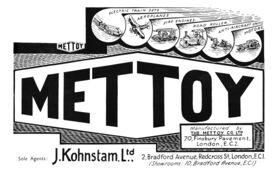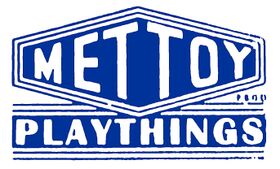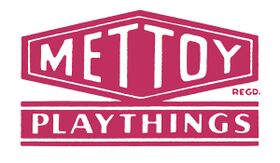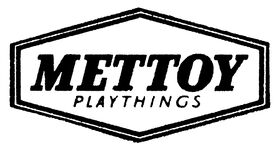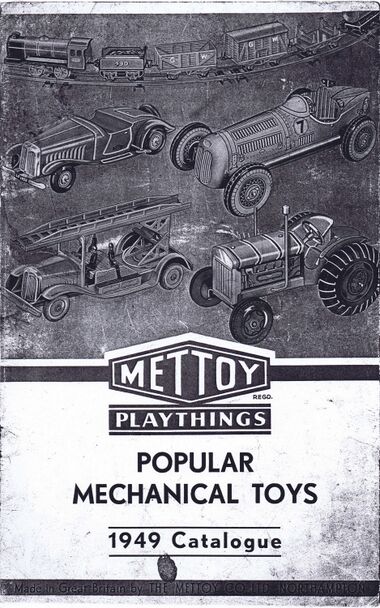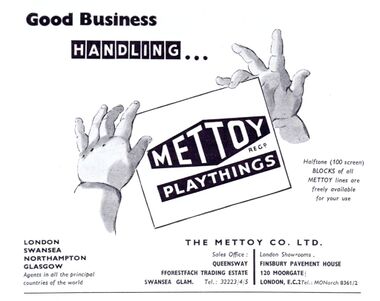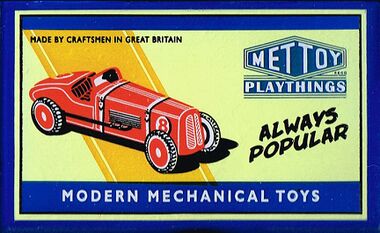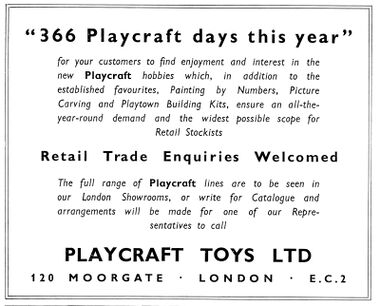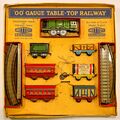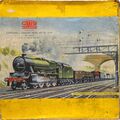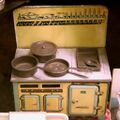Category:Mettoy
| Toy Brands and Manufacturers |
|---|
Mettoy |
| 1932 - |
1949 catalogue cover, photocopy [image info]
1956 "Mettoy Playthings" trade advert [image info]
"Mettoy Playthings, Modern Mechanical Toys", "Always Popular", "Made by Craftsmen in Great Britain" [image info]
Mettoy Company Ltd. was founded in the UK in the early 1930s by Philipp Ullmann (1883-1971) (who'd been Managing Director of Tipp & Co., and relaunched it as TippCo) and South-Africa-born Arthur Katz (1908-1999) (a relative of Ullmann who had also worked at TippCo in Nuremberg).
Both had been part of the Nuremburg area's toy industry community until the rise of the Nazi Party forced them to leave Germany. The fact that Katx had been born in South Africa meant that he had a British passport and was able to leave for England comparatively easily: Ullmann had more difficulty, and made the journey later.
The Mettoy name was registered in 1932, and the company commenced making traditional Nuremburg-style tinplate lithographed toys (with or without clockwork motors) in 1934, at a site in Northampton owned by Bassett-Lowke’s Winteringham Ltd. Wenman Joseph Bassett-Lowke had extensive contacts in Germany, and may well have helped the pair get set up. They moved to a larger workspace in 1937, but initially stayed in Northampton.
As with most toy manufacturers, production switched to war work during World War Two, and Mettoy Company PLC’s wartime production focused on pressed steel products such as canisters and ammunition boxes, which forced the company to look at new processes and techniques, and move beyond their original "comfort zone" of Nuremberg-style lithoed tinplate.
Towards the end of the War, Mettoy started planning a major new factory in Fforestfach, Swansea, Wales, with work starting in 1948, and the factory being opened in 1949 by George VI. The Welsh connection influenced at least two subsequent Mettoy brandnames, Corgi Toys diecast toy cars and Dragon computers.
Evolution
Mettoy's earlier products were extremely similar to what you might expect from a traditional German lithographed tinplate toy manufacturer, to the extent that if it wasn't for the "MADE IN ENGLAND" mark, one could be forgiven for mistaking some of the tinplate motorcycles, cars and railway sets as having been produced by a smaller German maker. Although not especially original (to the point where some peope have characterised them as essentially being "copies" of German designs), these were, pragmatically, the sorts of toys that new UK immigrants Ullman and Katz already knew how to make, distribute and sell.
As the company matured, its offerings became more distinctive. Its range of lorries, although simple, were very much based on contemprary British lorry cab designs, and the Mettype toy typewriters were unusual and easily recognisable. Mettoy pushed the limits of how large one could make lithographed tinplate toys with its dollhouse and hosptital and garage "play buildings".
However, the status and importance of Mettoy changed with the opening of its new plant in Fforestfach, Wales, it's hiring of designer Marcel R. van Cleemput, and its merger with Katz' Playcraft company, which together made possible the creation of Corgi Toys. The Corgi range were the first of the "second-generation" diecast toy vehicles, and blew away the competition for diecast toy cars in terms of quality, sophistication, innovation, and sheer downright niceness. As a result, Mettoy are chiefly remembered today, not so much for its lithographed tinplate toys, as for being the "ancestor" company that gave rise to Mettoy-Playcraft and Corgi Toys.
Ranges
- Under the Mettoy and Mettoy Playthings branding, Mettoy produced lithographed tinplate cars, commercial vehicles (lorries and buses), fire engines, clockwork aeroplanes and toy kitchenware.
- The Mettype brand was used for toy typewriters incorporating a facsimile lithographed image of a conventional typewriter keyboard, but which worked by rotating a central dial to select a letter, and then pushing down on a lever-pad.
- The Mettoy Railways brand was used for gauge 0 tinplate clockwork trains and train sets, running on tinplate rails.
- The Joytown brand was used for small tinplate buildings like railway stations and garages, and also for tinplate tracked roadway systems.
In the 1960s, Mettoy also produced larger tinplate buildings, including a multi-storey hospital building, a multi-storey garage, and a two-storey dollhouse.
1939 catalogue review:
Mettoy Co. Ltd.
The Mettoy Co. Ltd. have issued a very attractive catalogue for 1939. The front cover is of light blue and silver with dark blue printing. The catalogue contains 28 pages, 27 of which are fully illustrated. A unique feature is that each line mentioned is detailed in three languages – English, French and Spanish.
This firm are manufacturers of mechanical toys and trains. Monoplanes, biplanes and autogyros occupy over two pages. A novel line is the No. 12 B7 biplane. This has two lights, sparking gun and running propellor. Another interesting number is No. 14/7 monoplane, running and flying with detachable wing and two lights – one green and one red. Filling stations, with and without cars, are mentioned, as well as an aerodrome with cruising aeroplane. There are many numbers shown in miniature cars, and these represent various types, such as roadsters, sports cars, limousines, cabriolets, one of the latter having sliding roof and two electric lights. Then there are two models shown of racing cars, one of these having a turntable electric searchlight. Another line is a car with a caravan. Four illustrations appear of fire engines, No. 111 having ladder and searchlight.
In lorries illustrations appear of 17 numbers, and these cover a wide variety. Also shown are army anti-aircraft units, motor-cycles, a lighthouse with three cruising aeroplanes and light, steam and road rollers, and a large low truck with two lights, heavy dipped finish.
The Mettoy Co. Ltd. are also manufacturers of brush and pan sets, telephones, stove utensils, kitchen stoves. These are well-finished lines.
— , Catalogues Received, , Games and Toys, , July 1939
Playcraft
Playcraft trade advert, 1956 [image info]
After the success of Mettoy, Katz founded Playcraft Toys Ltd. as a separate company in 1949 to explore manufacturing of plastic toys. By 1956, Playcraft were advertising their main range as being "Painting by Numbers", "Picture Carving" and "Playtown Building Kits".
Playcraft branched out into plastic kits, model railways, and slotcars, and the range of toys and games that they made and/or distributed also included some sports goods, such as footballs.
Mettoy Playcraft
After Playcraft had established itself as a viable company, Katz merged it into Mettoy to form Mettoy-Playcraft, a broader-based company that now had specialist skills in both plastics and metal fabrication.
By starting the separate company and then only merging it into Mettoy once it was mature, Katz helped Mettoy-Playcraft establish a broadened set of manufacturing skills and cultures in which the development and manufacture of non-metal toys was not considered to be just an afterthought or sideline, and helped the business to avoid the trap that Meccano Ltd. fell into, of being a dedicated metal toy manufacturer that had trouble understanding the new markets, and trouble recruiting experienced management that did. Playcraft was able to build up its skill sets in plastics manufacture as an independent company whose staff didn't risk being sidelined or sabotaged by the Mettoy metalworking culture, and when Playcraft became part of the new company, its staff were able to command the respect due to their having proved themselves as having been able to run a legitimate toymaking business by themselves.
Corgi
With metal and plastics fabrication techniques firmly established, in 1956 Mettoy-Playcraft then decided to tackle Meccano Ltd.'s Dinky Toys market head-on, with their own new range of diecast metal toy cars, Corgi Toys - a name probably inspired by the dog breed’s Welsh background and Royal connections.
Corgi put plastic seats and interiors and clear plastic windows into their diecast vehicles, and their selling slogan "The Ones with Windows" dented Dinky's image (being relegated to being "The Ones without Windows"), and Corgi did very well for themselves for a couple of decades.
Dragon
Mettoy-Playcraft's determination to move with the times and not to be prisoners of the manufacturing technologies that they started with even resulted in a range of small computers in the early 1980s under the name "Dragon" (another animal with Welsh associations).
Addresses
- Mettoy -- Stimpson Avenue, Northampton
- Mettoy -- 14, Harlestone Road, Northampton NN5 7AE
- Mettoy -- 2, Queensway, Fforest Fach, Swansea SA5 4DH
External links
- Obituary: Arthur Katz (independent.co.uk)
- Arthur Katz, 91, the Maker Of Corgi Toy Cars, Is Dead (nytimes.com)
- Mettoy Co (gracesguide.co.uk)
- Mettoy and Corgi Toys (blog.nationalarchives.gov.uk)
- Mettoy Plastic (planetdiecast.com)
- Mettoy Castoys (rodgersantiques.co.uk)
- Tipp & Co, Mettoy and Marx Toy Typewriters: All the Work of Sammy Berger (oztypewriter.blogspot.com)
fforestfach:
- Mettoy factory, Wales (fforestfachhistory.com)
- Mettoy Factory, Fforest Fach, 1972 (peoplescollection.wales)
- Views of Mettoy factory, Fforestfach showing building 'W', 1950 (britainfromabove.org.uk)
- National Monuments Record of Wales (NMRW) : Mettoy Factory, White City Road, Fforestfach, Swansea (coflein.gov.uk)
- Inside the Mettoy Factory in Fforestfach, Swansea (walesonline.co.uk)
- Voices from the Factory Floor, Forestfach (factorywomensvoices.wales)
- Swansea Mettoy's tyre factory fire cost to top £1.5m (bbc.co.uk) -- 23 August 2011
dragon:
Subcategories
This category has the following 12 subcategories, out of 12 total.
A
- Mettoy aircraft (2 P, 8 F)
C
- Castoys (1 P, 1 F)
- Computacar (2 P)
J
- Joytown (1 P)
K
- Kleeware for Mettoy (6 P, 11 F)
M
- Mettoy Motor Cycles (1 P, 5 F)
P
R
- Mettoy Railways (2 P, 9 F)
T
- Mettype and Supertype typewriters (2 P, 5 F)
Pages in category ‘Mettoy’
The following 24 pages are in this category, out of 24 total.
C
F
M
Media in category ‘Mettoy’
The following 67 files are in this category, out of 67 total.
- Airport with Four Planes Mettoy 2163 (MettoyCat 1940s).jpg 3,000 × 2,100; 765 KB
- Bathroom set (Kleeware for Mettoy).jpg 2,504 × 1,606; 337 KB
- Bedroom set (Kleeware for Mettoy).jpg 2,504 × 1,606; 418 KB
- Box base, Mettoy Dolls House Furniture (Kleeware for Mettoy).jpg 1,241 × 1,600; 279 KB
- Camouflaged Staff Car M432013 (Mettoy).jpg 3,000 × 2,000; 740 KB
- Car and Trailer, YMCA Tea Car, Mettoy 3035 (MettoyCat 1940s).jpg 3,000 × 1,480; 579 KB
- Combination Train Set, Mettoy 5555 (MettoyCat 1940s).jpg 3,000 × 1,448; 613 KB
- Combination Train Set, Mettoy 5555, box contents (MettoyCat 1940s).jpg 885 × 1,257; 273 KB
- Combination Train Set, Mettoy 5560 (MettoyCat 1940s).jpg 3,000 × 1,391; 551 KB
- Combination Train Set, Mettoy 5560, box contents (MettoyCat 1940s).jpg 864 × 1,381; 272 KB
- Detail, Metal Dollhouse (Mettoy 6254).jpg 3,000 × 2,000; 1.05 MB
- Dining Room and Lounge (Kleeware and Mettoy, 1950s).jpg 3,000 × 1,690; 637 KB
- Dining Room set (Kleeware for Mettoy).jpg 2,504 × 1,606; 405 KB
- Fire Engine, Mettoy 3104 (MettoyCat 1940s).jpg 2,473 × 1,693; 373 KB
- Foden Eight-Wheeled Articulated Lorry and Trailer (Mettoy).jpg 2,000 × 1,043; 421 KB
- Freight or Passenger Train Set, box contents (Mettoy Railways 5730).jpg 2,999 × 3,000; 1.67 MB
- Freight or Passenger Train Set, box lid (Mettoy Railways 5730).jpg 3,000 × 3,000; 1.24 MB
- Green tinplate locomotive (Mettoy Railways).jpg 2,000 × 1,334; 268 KB
- Junior Flyer Floor Train, box lid (Mettoy Playthings).JPG 3,000 × 2,256; 992 KB
- Kitchen set (Kleeware for Mettoy).jpg 3,732 × 1,606; 556 KB
- Large Army MotorCycle, Mettoy 3158 (MettoyCat 1940s).jpg 2,299 × 1,563; 474 KB
- Large Box Transport Van, Mettoy 3123-1 (MettoyCat 1940s).jpg 2,619 × 1,684; 660 KB
- Large Fire Engine, Mettoy 3104 (MettoyCat 1940s).jpg 3,000 × 2,037; 720 KB
- Large Limousine, Mettoy 3070 (MettoyCat 1940s).jpg 3,000 × 1,863; 485 KB
- Lounge set (Kleeware for Mettoy).jpg 2,504 × 1,606; 419 KB
- Metal Dollhouse and plastic furniture (Mettoy).jpg 3,000 × 2,137; 999 KB
- Mettoy Co Ltd (GaT 1939).jpg 2,183 × 1,366; 361 KB
- Mettoy Dolls House Furniture (Kleeware for Mettoy).jpg 1,600 × 1,244; 182 KB
- Mettoy Playcraft logo 1970.jpg 625 × 218; 20 KB
- Mettoy Playthings trade advert (GaT 1956).jpg 1,024 × 811; 88 KB
- Mettoy Playthings, Always Popular, Mettoy Modern Mechanical Toys.jpg 1,151 × 705; 153 KB
- Mettoy Playthings, logo (Kleeware for Mettoy).jpg 1,200 × 697; 94 KB
- Mettoy Playthings, logo (~1962).jpg 1,800 × 969; 266 KB
- Mettoy Playthings, logo.jpg 1,372 × 829; 161 KB
- Mettoy Railways logo.jpg 2,343 × 1,381; 569 KB
- Mettoy Real Action Motor Cycles (MettoyCat 1940s).jpg 2,316 × 3,000; 1.26 MB
- Mettype Junior Typewriter (Mettoy).jpg 1,800 × 1,350; 449 KB
- Monoplane K2010 (Mettoy).jpg 1,600 × 962; 218 KB
- Monoplane K3520 (Mettoy).jpg 1,200 × 750; 121 KB
- Monoplane K3520, Mettoy 2011 (MettoyCat 1940s).jpg 3,000 × 1,492; 403 KB
- Monoplane, Mettoy 2007 (MettoyCat 1940s).jpg 3,000 × 1,604; 381 KB
- Monoplane, Mettoy 2009 (MettoyCat 1940s).jpg 3,000 × 1,680; 484 KB
- Monoplane, Mettoy 2012 (MettoyCat 1940s).jpg 2,969 × 1,705; 524 KB
- Monoplane, Mettoy 2016 (MettoyCat 1940s).jpg 3,000 × 1,899; 565 KB
- Motorcycle, Mettoy 3148-1 (MettoyCat 1940s).jpg 2,160 × 1,085; 308 KB
- Motorcycle, Mettoy 3149 (MettoyCat 1940s).jpg 2,069 × 1,565; 429 KB
- Mr Porter, Mystery Action Railway Trolley (Mettoy).jpg 1,198 × 1,600; 227 KB
- Nursery set (Kleeware for Mettoy).jpg 3,732 × 1,606; 607 KB
- Police Patrol Motorcycle (Mettoy 3149).jpg 3,000 × 1,800; 883 KB
- Pool Petrol Lorry, Mettoy 3114 (MettoyCat 1940s).jpg 2,011 × 1,245; 307 KB
- Popular Mechanical Toys, Mettoy Playthings, photocopy, cover (Mettoycat 1949-01).jpg 1,874 × 3,000; 1.69 MB
- Popular Mechanical Toys, Mettoy Playthings, photocopy, intro (Mettoycat 1949-01).jpg 2,136 × 3,000; 485 KB
- Racing Car, Mettoy 3088 (MettoyCat 1940s).jpg 2,758 × 1,623; 435 KB
- Removal Van, Mettoy 3116B (MettoyCat 1940s).jpg 1,931 × 1,433; 438 KB
- Roadster, Mettoy 3023 (MettoyCat 1940s).jpg 2,281 × 1,158; 313 KB
- Rolls Royce Limousine, Mettoy 3074 (MettoyCat 1940s).jpg 3,000 × 1,886; 440 KB
- Searchlight Lorry, camouflaged (Mettoy).jpg 3,000 × 1,727; 748 KB
- Six-Wheel Tipper Lorry, Mettoy 3124 (MettoyCat 1940s).jpg 3,000 × 1,619; 433 KB
- Six-Wheeler Lorry, Mettoy 3118 (MettoyCat 1940s).jpg 2,199 × 1,266; 340 KB
- Spirit-Fired Stove (Mettoy Playthings).jpg 1,024 × 1,024; 190 KB
- Staff Car, Mettoy 3035 (MettoyCat 1940s).jpg 2,431 × 1,380; 458 KB
- Streamline Bus, Castoys, MTY820 (Mettoy 820).jpg 1,600 × 1,200; 255 KB
- Supertype toy typewriter, box (Mettoy 4317).jpg 1,200 × 715; 151 KB
- Supertype toy typewriter, box base (Mettoy 4317).jpg 3,000 × 1,823; 672 KB
- Supertype toy typewriter, detail (Mettoy 4317).jpg 3,000 × 2,000; 701 KB
- Supertype toy typewriter, open box (Mettoy 4317).jpg 3,000 × 2,210; 721 KB
- Tip Lorry, Mettoy 3116 (MettoyCat 1940s).jpg 1,996 × 1,235; 299 KB
